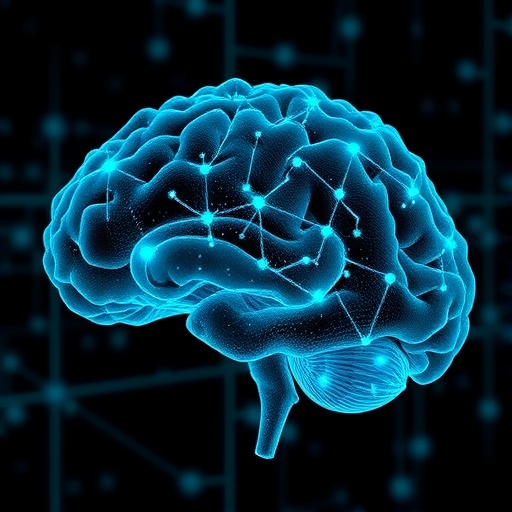In a remarkable leap forward for cancer nanotechnology, scientists have unveiled groundbreaking research on the use of graphene quantum dot-integrated nanocomposites as a novel therapeutic strategy against glioblastoma, an aggressive and notoriously treatment-resistant brain tumor. This innovative approach leverages the unique physicochemical properties of graphene quantum dots (GQDs) to enhance delivery, targeting, and efficacy of anti-cancer agents within the brain’s complex environment, heralding a promising new frontier in oncological treatment.
Glioblastoma multiforme (GBM) remains one of the deadliest forms of brain cancer, characterized by rapid growth, diffuse infiltration into surrounding brain tissue, and resistance to conventional therapies such as surgery, radiotherapy, and chemotherapy. The median survival rate for patients hovers around 15 months post-diagnosis, underscoring the urgent need for more effective therapeutic modalities. The integration of graphene quantum dots within nanocomposites emerges as a beacon of hope, capitalizing on the exceptional attributes of graphene-based nanomaterials to overcome existing limitations in glioblastoma treatment.
Graphene quantum dots are ultrafine, nanoscale fragments of graphene sheets exhibiting unique quantum confinement and edge effects. These properties endow GQDs with superior biocompatibility, tunable photoluminescence, remarkable surface area, and facile functionalization capabilities. When embedded into nanocomposites, these quantum dots enhance the platform’s capacity for drug loading, controlled release, and deep tissue penetration—critical parameters for effectively targeting GBM cells dispersed within the brain’s intricate architecture.
The research detailed by Unidirwade, Lade, Umekar, and colleagues meticulously explores the synthesis, characterization, and biological performance of these GQD-integrated nanocomposites. By engineering the nanocomposites to possess optimized size, surface chemistry, and charge, the team achieved improved blood-brain barrier (BBB) permeability—a formidable obstacle that has historically hindered efficient drug delivery to brain tumors. Such advancements directly address a central challenge in neuro-oncology, whereby therapeutic agents often fail to reach adequate concentrations at the tumor site.
Beyond enhanced delivery, graphene quantum dots impart additional therapeutic functionalities. Their intrinsic photoluminescence permits real-time imaging and tracking of the nanocomposites within biological systems, enabling precision in monitoring distribution and accumulation within glioblastoma tissues. Furthermore, GQDs exhibit photothermal properties, whereby exposure to near-infrared light can induce localized heating, triggering tumor cell apoptosis while sparing healthy brain cells—this multi-modal approach synergistically combines chemotherapy with photothermal therapy for potentiated anti-tumor activity.
Critically, the cytotoxicity assays presented confirm that GQD-based nanocomposites maintain high biocompatibility with normal brain cells while exerting targeted cytotoxic effects against glioblastoma cell lines. This selectivity minimizes off-target damage, a major concern in brain cancer treatments, thus promising improved patient safety profiles. The ability to achieve such selective toxicity underscores the transformative potential of nanomanipulation strategies in precision oncology.
Mechanistically, the study elucidates cellular uptake pathways of these nanocomposites, demonstrating that their physicochemical modifications enable efficient endocytosis by GBM cells. Intracellular trafficking studies reveal that once internalized, the nanocomposites localize predominantly within lysosomes and the cytoplasm, facilitating the release of encapsulated anti-cancer drugs in a spatially controlled manner. This precise intracellular delivery enhances cytotoxic efficacy while mitigating systemic side effects.
In vivo experimentation conducted on glioblastoma-bearing animal models corroborates the translational promise of this technology. Treated subjects exhibited significant tumor regression, prolonged survival time, and reduced neurologic deficits compared to control groups receiving standard chemotherapy alone. Imaging data further validated the ability of GQD-nanocomposites to accumulate selectively in tumor tissue, highlighting their targeting efficiency and real-time imaging capability.
The modular nature of graphene quantum dot integration allows for facile customization of the nanocomposite surface with targeting ligands such as peptides, antibodies, or aptamers that recognize glioblastoma-specific biomarkers. Such functionalization not only improves selectivity but also addresses the heterogeneity inherent in GBM tumors, potentially mitigating resistance mechanisms that frequently lead to therapeutic failure.
Intriguingly, the photostability and chemical robustness of graphene quantum dots impart durability to these nanoconstructs, ensuring sustained therapeutic effect and reproducibility across repeated treatment cycles. This contrasts with some organic nanoparticles susceptible to rapid degradation or aggregation, which impair clinical applicability. Consequently, GQD-integrated platforms may offer superior consistency in treatment outcomes.
Although promising, several translational hurdles remain to be addressed before clinical application. Scalability of high-quality graphene quantum dots, long-term toxicity profiles, and comprehensive pharmacokinetics require extensive investigation. Moreover, the complex immunological landscape of the brain mandates rigorous assessment to preclude unintended inflammatory or immunosuppressive effects induced by the nanocomposites.
Nonetheless, the multidisciplinary collaboration embodied in this research—from material science to oncology to neurobiology—exemplifies the innovative spirit necessary to tackle formidable challenges like glioblastoma. The convergence of nanotechnology and cancer therapy continues to pave a new paradigm that could fundamentally shift current clinical approaches and improve patient prognoses in one of the most challenging diseases.
In conclusion, the development of graphene quantum dot-integrated nanocomposites offers a highly promising avenue toward more effective, precise, and multimodal glioblastoma treatment. By dramatically enhancing drug delivery across the blood-brain barrier, enabling real-time imaging, and synergistically combining chemotherapeutic and photothermal modalities, this technology stands poised to redefine the therapeutic landscape. As research progresses, clinical translation may well transform this nanotechnological marvel from benchside innovation into a lifeline for brain tumor patients worldwide.
Subject to further exploration and clinical validation, graphene quantum dot-integrated nanocomposites represent the vanguard of next-generation nanomedicine platforms, underscoring the profound impact that advanced materials science can impart on resolving pressing medical crises. Their versatility, efficacy, and safety profile warrant continued investment and research, holding the potential to unlock new horizons in cancer therapy—and beyond.
Subject of Research: Development and evaluation of graphene quantum dot-integrated nanocomposites for targeted treatment of glioblastoma.
Article Title: Graphene quantum dot-integrated nanocomposites: a promising avenue for glioblastoma treatment.
Article References:
Unidirwade, D.S., Lade, S.N., Umekar, M.J. et al. Graphene quantum dot-integrated nanocomposites: a promising avenue for glioblastoma treatment.
Med Oncol 42, 417 (2025). https://doi.org/10.1007/s12032-025-02967-z
Image Credits: AI Generated




